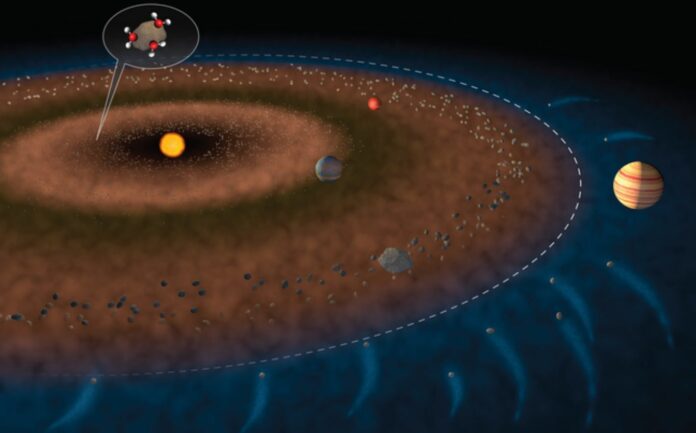How Did Earth Get its Water? Scientists One Step Closer to Solving Mystery of Earth’s Water Origin
Water, a fundamental component of life, covers a whopping 71% of the Earth’s surface. However, the mystery surrounding its arrival on our planet still remains unsolved. Despite numerous attempts, scientists are yet to determine when and how this colossal amount of water made its way to Earth. This perplexing question continues to baffle researchers and remains an intriguing topic of investigation in the scientific community.
In a recent publication in the esteemed scientific journal Nature, researchers have made significant progress towards solving the mystery of how water arrived on Earth. Led by Megan Newcombe, an Assistant Professor of Geology at the University of Maryland, the team conducted a study analyzing melted meteorites that had been present in space since the formation of our solar system approximately 4.5 billion years ago. The findings were startling, with the extraterrestrial materials being some of the driest ever measured, suggesting that the water on Earth did not come from these meteorites.
These findings allowed scientists to exclude them as the main source of Earth’s water, which may have significant ramifications for the hunt for water—and life—on other worlds. It also helps scientists figure out how the Earth came to be a place where people can live.
Newcombe says they “wanted to understand how our planet managed to get water because it’s not completely obvious. Getting water and having surface oceans on a planet that is small and relatively near the sun is a challenge.”
The study team examined seven melted (or achondrite) meteorites that struck Earth billions of years ago after breaking off from at least five planetesimals, the objects that collided to create the planets in our solar system. Several of these planetesimals were heated up by radioactive element decay in the early solar system’s history, forcing them to split into layers with a crust, mantle, and core in a process known as melting.
This experiment marked the first instance in which the volatiles of these meteorites had ever been measured, likely due to their recent arrival on Earth. To conduct the measurements, Liam Peterson, a geology graduate student at UMD, utilized an electron microprobe to assess the levels of magnesium, iron, calcium, and silicon present within the meteorites. Following this, Peterson collaborated with Newcombe at the Earth and Planets Laboratory of the Carnegie Institution for Science to use a secondary ion mass spectrometry instrument to measure the water content of the meteorites.
“The challenge of analyzing water in extremely dry materials,” according to co-author Conel Alexander, “is that any terrestrial water on the sample’s surface or inside the measuring instrument can easily be detected, tainting the results.”
To prevent contamination, scientists first roasted their samples in a vacuum oven at a low temperature to eliminate any surface water. The samples needed to be dried out again before they could be examined in the secondary ion mass spectrometer.
“I had to leave the samples under a turbo pump—a really high-quality vacuum—for more than a month to draw down the terrestrial water enough,” Newcombe adds.
Certain meteorite samples were sourced from the inner solar system, the same region where Earth exists, and where the prevailing assumption is that conditions were warm and arid. Comparatively uncommon samples were procured from the frigid, more remote regions of our planetary system. Though it was generally believed that water was brought to Earth from the outer solar system, the particular kinds of objects capable of transporting that water across the solar system remain to be identified.
Sune Nielsen, a study co-author says that they “knew that plenty of outer solar system objects were differentiated, but it was sort of implicitly assumed that because they were from the outer solar system, they must also contain a lot of water.”
This work “shows this is definitely not the case. As soon as meteorites melt, there is no remaining water.”
Newcombe and her co-authors analyzed achondrite meteorite samples and found that these samples contained less than two millionths of their mass in water. In contrast, the wettest meteorites, known as carbonaceous chondrites, can contain up to about 20% water by weight, which is 100,000 times more than the water content in the achondrite meteorite samples studied by the researchers.
According to the findings, planetesimals undergo heating and melting, resulting in almost complete water loss, regardless of their origin or initial water content within the solar system. The popular assumption that all outer solar system objects are abundant in water was challenged by their discovery that some are not. As a result, they concluded that water on Earth most likely arrived via unmelted meteorites, known as chondrites.
Newcombe emphasized that their discoveries hold significance beyond just geology. Researchers from various fields, particularly those studying exoplanets, are intrigued by the source of Earth’s water due to its profound association with life.
“Water is considered to be an ingredient for life to be able to flourish, so as we’re looking out into the universe and finding all of these exoplanets, we’re starting to work out which of those planetary systems could be potential hosts for life,” Newcombe adds. “In order to be able to understand these other solar systems, we want to understand our own.”
Source: 10.1038/s41586-023-05721-5
Image Credit:
